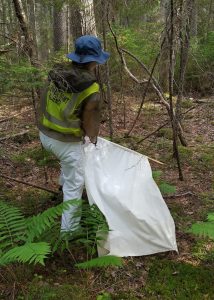Mitigating Environmental-Human Determinants of Tickborne Disease Risk in Acadia National Park
 Institution: University of Maine
Institution: University of Maine
Sponsor: Senator George J. Mitchell Center for Sustainability Solutions
Resource stewardship in parks and natural areas encompasses promoting both healthy ecosystems and healthy visitors. In Acadia National Park (ANP), millions of tourists and outdoor enthusiasts per year are at risk of exposure to a suite of pathogens transmitted by hard-bodied ticks.
Maine has seen a five-fold increase in Lyme disease cases over the past decade, while several emerging tickborne diseases (e.g., babesiosis, anaplasmosis, Powassan virus) are on the rise. Both visitors and residents of Mount Desert Island have recognized the growing burden on human health posed by tickborne disease.
In a recent survey led by this project’s lead investigator Sandra De Urioste-Stone, ANP visitors identified heightened risk of exposure to vector-borne disease as one of their top concerns among the myriad potential consequences of climate change for outdoor recreation. In 2014, Bar Harbor residents deliberated culling white-tailed deer to curb Lyme disease transmission.
Recent interviews with key informants in the study area suggest that research is needed to better understand the effects of visitor health risk perceptions on travel behavior, and potential implications for sustainable visitor and natural resource management.
Risk of Lyme disease is expected to continue to increase under climate change due to a combination of environmental and social factors. First, climate change is expected to increase entomological risk of exposure to Lyme disease (i.e., density of infected nymphs) due to increased overwinter survival of ticks, increased seasons when ticks are actively seeking hosts, and modified cycles of vector (ticks) -host (rodents, deer) interactions.
Second, climate change may increase the human population at risk of exposure to Lyme disease via increased visitation to parks, including extended visitation in periods between high and low numbers of tourism(which coincide with peak periods of adult black-legged tick activity), and an overall increase in visitor numbers due to warmer temperatures. Thus, managing risk of exposure to Lyme disease is an interdisciplinary endeavor that requires understanding both disease ecology and human behavior.
This collaborative project aims to:
- Develop a model that can be replicated in other locations, that integrates data from biological, climate, and social science research to identify ecological and socio-cultural factors that mediate risk of human exposure to Lyme disease transmission
- Generate solutions in collaboration with research partners.
Over several years, researchers have built a diverse team of stakeholder partners with extensive collective experience engaging in interdisciplinary, solutions-oriented research, including one of only two epidemiologists in the federal National Park Service (NPS), ecologists at ANP, and a leading tickborne disease expert at the Maine Medical Center Research Institute. The research framework devised and tested in ANP will be transferable to other settings in Maine, and through our NPS collaborations, to other national parks in the United States.
Research Objectives
This project integrates:
- Assessment of visitor perceptions of health risks (i.e., exposure to ticks and Lyme disease) and travel behavior during peak and shoulder seasons
- Evaluation of entomological risk of exposure to Lyme disease across a range of microclimate and habitat conditions throughout ANP
- Investigation of the effects of microclimate and habitat on the abundance, distribution, and tick loads of small mammal reservoir hosts of the pathogen or microorganism (e.g., bacteria, viruses, parasites) that cause Lyme disease (Borrelia burgdorferi)
- Comparison of objective risk (i.e., the abundance and spatial distribution of ticks and small mammals infected with burgdorferi) to visitor perceived risk (visitor attitudes, norms, knowledge) and travel behavior in a spatial framework
- Integration and sharing of results with park managers and other nature-based tourism stakeholders to jointly develop best practice strategies to reduce health risks and increase adaptive capacity at the destination.
Team Leader
Sandra De Urioste-Stone, Assistant Professor of Nature-based Tourism, School of Forest Resources, Mitchell Center Faculty Fellow, UMaine
UMaine Team Members
- Allison Gardner, Assistant Professor of Arthropod Vector Biology, School of Biology and Ecology, Mitchell Center Faculty Fellow, UMaine
- Danielle Levesque, Assistant Professor of Mammalogy and Mammalian Health , School of Biology and Ecology, UMaine
- Sean Birkel, Maine State Climatologist, Research Assistant Professor, Climate Change Institute , School of Earth and Climate Sciences, UMaine
External Partners
Resources:
- News Article 7/19/18: Team awarded $1.17M to help protect forest workers from tick-borne illnesses
- News Article 6/26/18: IURC Funds Four Sustainability Projects
- News Article 9/18/18: Of Ticks and Tourists
- Publication: Soucy, A. & De Urioste-Stone (2020). Tourist behaviour and tick-borne disease risk. WIT Transactions of Ecology and the Environment, 248, 77-88. doi: 10.2495/ST200071
